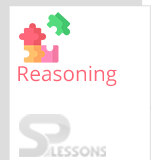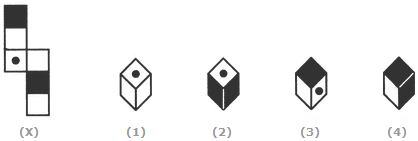 Introduction
Introduction
Logical Reasoning is an important section in the Competitive Exams throughout the globe. Logical reasoning is primarily designed to test the aptitude skills of the candidates taking the exams. Cubes and Dice related questions are frequently seen in several competitive exams including recruitment exams in India such as SSC CGL, Banking, Railways, and other exams such as CAT, GRE, GMAT, etc. The article Cubes and Dice Practice Quiz 2 lists some practice questions that will apply different concepts of cubes and dice.
What is a Dice?
A Dice is a Cube. A cube has 6 squares faces/sides and 8 vertices/corners, and 12 edges. Only 3 sides of a cube are visible at any given time. These sides are known as adjacent sides and can never be to the opposite side of each other. A Dice usually has numbers labelled 1 to 6.
 Quiz
Quiz
1. What will be the number at the bottom, if 5 is at the top; the two positions of the dice being as given below:
- A. 1
B. 2
C. 3
D. 6
- A. 1
B. 2
C. 3
D. 4
- A. 2
B. 3
C. 4
D. 6
- A. 2
B. 4
C. 5
D. 6
- A. 2
B. 4
C. 5
D. 6
1. Three different positions X, Y and Z of a dice are shown in the figures given below. Which number lies at the bottom face in position X?
- A. 2
B. 3
C. 6
D. Cannot be determined
- A. 1 is opposite to 5
B. 4 is opposite to 6
C. 4 is adjacent to 2 and 6
D. 1 is adjacent to 2 and 3
- A. 2
B. 3
C. 5
D. Cannot be determined
- A. 3
B. 5
C. 6
D. Cannot be determined
- A. 1
B. 2
C. 4
D. 5
Direction [1 - 5] : The sheet of paper shown in the figure (X) given on the left hand side, in each problem, is folded to form a box. Choose from amongst the alternatives (1), (2), (3) and (4), the boxes that are similar to the box that will be formed.
1. Choose the box that is similar to the box formed from the given sheet of paper (X).
- A. 1 only
B. 1 and 3 only
C. 1, 3 and 4 only
D. 1, 2, 3 and 4
- A. 1 only
B. 2 only
C. 1 and 3 only
D. 1, 2, 3 and 4 only
- A. 1 only
B. 2 only
C. 3 only
D. 4 only
- A. 1 only
B. 2 only
C. 3 only
D. 4 only
- A. 2 and 3 only
B. 1, 3 and 4 only
C. 2 and 4 only
D. 1 and 4 only

















